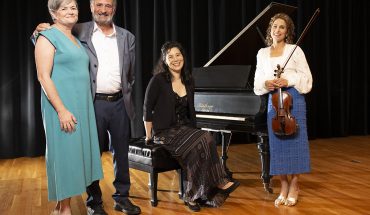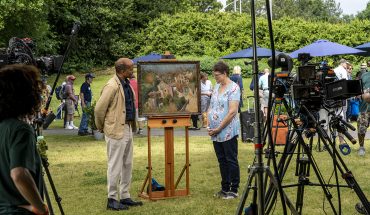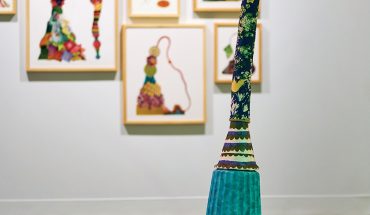The Americans with Disabilities Act celebrates 30 years, and our local arts scene is making strides to include people of all abilities.
by Andrea Rice
As the Americans with Disabilities Act (ADA) celebrates its 30th anniversary this year, our arts scene is gaining attention for both elevating the voices of artists with disabilities and making spaces more inclusive to those who live with them. This summer, Raleigh was scheduled to host the John F. Kennedy Center’s Leadership Exchange in Arts and Disability (LEAD) Conference, but it was rescheduled for 2021 due to the pandemic. “We hope we’ll be able to showcase some of Raleigh’s access achievements then,” says Sarah Corrin, arts grant director for the City of Raleigh Parks, Recreation and Cultural Resources.
PROMOTING PERSPECTIVES
Around one in four adults in North Carolina has a visual, auditory, motor or cognitive disability. And particularly in recent years, our arts institutions have recognized the talents and perspectives of artists with disabilities by showcasing work that offers a glimpse into disability life and culture. VAE hosted The Everyday (2018), a multi-faceted project that highlighted shared experiences of those who live with a disability, and The Full Light of Day (2020), which featured artists with disabilities drawing awareness to their lived experience. At CAM, Justin LeBlanc’s Probable Normal Hearing (2019) told the story of the fashion designer’s journey as a person with hearing loss. Last year, Artspace hosted Katie Shaw, a Richmond-based artist with multiple sclerosis, for a month-long residency followed by an exhibit. (The residency will be offered again, open to any artist that identifies as having a disability.) The Raleigh Little Theatre often casts actors with disabilities, including recent productions of Pippin (2019) featuring two actors that are blind and The Curious Incident of the Dog in the Night-Time (2019), starring an actor who has autism, as does the character he portrayed.
Wiley Johnson, a painter who has autism spectrum disorder, has shown his work at multiple local exhibitions in recent years. “I don’t think artists should be recognized because they have autism spectrum disorder or any particular disability,” Johnson says. “I think that they should be recognized through acceptance in art like other artists.” This summer, three of Johnson’s paintings were accepted into a juried art call for the ReAwakening exhibit (through September 27) at Durham’s Golden Belt Campus for the Arts and another at Pleiades Arts for Durham’s eighth annual Truth to Power show in August. Corrin says that the most important shift she’s seen over the past 30 years is the recognition of different disability perspectives. “A lot of that work is really cutting edge and thoughtprovoking,” she says.
BRINGING ART TO ALL
In addition to showcasing these artists, our cultural institutions have consciously incorporated more features and technologies that welcome audiences of all abilities. Corrin recalls her first job at Raleigh Little Theatre back in 1991, when the only accommodations that could be counted on were wheelchair ramps and audio description. “More organizations consistently offer a broader array of accommodations now, and they’re much better publicized,” Corrin says. “Advances in technology have been a game changer too—whether it’s beam robots in museums that allow people with mobility issues to attend exhibitions with friends without leaving home, or phone apps that provide verbal way-finding and artwork descriptions.”
Many of these advancements have been made possible (and free) through funding from the City of Raleigh Arts Commission and help from Arts Access, North Carolina’s first and only non-profit dedicated solely to making the arts accessible to people with disabilities. Founded in 1984, Arts Access works with arts professionals to improve how they engage with people with disabilities, including training on disability etiquette, language and bias; promoting inclusion in classrooms and programs; making online communication accessible and gearing outreach to different audiences. Around the Triangle and statewide, the nonprofit has been integral to making arts and culture offerings inclusive of children and adults with disabilities.
“Our philosophy is rooted in both education and advocacy,” says Betsy Ludwig, its executive director. “When people with disabilities share stories of barriers and discrimination in accessing arts and cultural opportunities, we work as allies to help them navigate those challenges.” The group works with arts organizations to get tools and information to minimize barriers, which can be both physical and attitudinal. Johnson credits Arts Access for helping him gain opportunities to exhibit at events like the Raleigh Woman’s Club Arts Festival and at The Walls We Build: (dis)Ability exhibition at Pleiades (2018), among others. “Most people I have come in contact with in the Raleigh art world have been kind and encouraging,” he says, “and I appreciate everything people have done to help me.”
The Arts Commission and the United Arts Council of Raleigh and Wake County have also partnered on the Arts Learning Community for Universal Access, a peer cohort devoted to increasing skills and knowledge of arts organization staff. The program was designed to catalyze change—from increasing Braille materials to enhancing website accessibility. Corrin says dozens of organizations have participated in the program so far, and not only have they implemented the recommendations, but that accessibility, in general, has started to become part of each entity’s DNA. “It’s no longer an add-on or afterthought,” she says. “It becomes integral to how they develop programming.”
Artspace is one such example: each of its galleries, classrooms, studios and public areas is fully accessible. They have an on-site wheelchair, signage with Braille lettering and exhibition brochures in Braille and large print (done through a partnership with the Governor Morehead School for the Blind). EnChroma glasses are available for visitors with color blindness, and recently, the gallery updated its tour program to include sensory materials for participants to feel and touch the materials used to make the work. They’ve also added audio descriptions to many exhibitions and set a goal to provide them for 50 percent of all upcoming exhibitions. And while the gallery remains closed during the pandemic, Artspace has been offering virtual tours and video interviews with closed captioning, as well as downloadable art activities and creativity guides. “Our educational programs are accessible to those with disabilities and we promote our willingness to make accommodations for students with disabilities in our program materials,” says Artspace president and CEO Mary Poole.
Similarly, VAE aims to make all of its offerings available and accessible to all who appreciate art—from audio tours to American Sign Language (ASL) interpretation to making information available in Braille. VAE executive director Brandon Cordrey says that the gallery makes a concerted effort to include people with disabilities not only in its gallery space and artist programming, but also on its committees. “We make sure we’re holding that accessibility lens to all of our work, even when it’s not project-specific,” says Cordrey.
The North Carolina Museum of Art leads tours for visitors with disabilities, including audio descriptions, closed-caption video resources, tactile tours and ASL tours. As the NCMA remains closed during the pandemic, the museum is working to make their virtual offerings accessible, too—including a “field trip” for those who are deaf or hearing impaired in partnership with the N.C. Department of Health and Human Services—and encourages guests to reach out before these events to properly accommodate them with an ASL interpreter, captions or other needs.
Concurrently, Corrin has observed an increase in consideration for creating welcoming experiences for people with autism spectrum disorder and other sensory sensitivities. “There are a growing number of sensory-friendly performances by organizations like the North Carolina Symphony and special museum programs at places like Marbles Kids Museum and CAM Raleigh,” Corrin says. “Raleigh Little Theatre took a big plunge when it committed to doing a sensory-friendly performance for each of its Family Series shows.”
Patrick Torres, artistic director at Raleigh Little Theatre, says the effort to offer sensory-friendly performances (which include a smaller audience so members can move around, noisereducing headphones and quiet zones) began almost three years ago as part of a national trend toward making the theater more accessible to all. In the past five years, they also installed a hearing loop in the main theater and implemented a campaign to redesign the lobby to bring it up to ADA standards. “We have seen this multifaceted approach—classes, performances, accommodations— help us develop new and meaningful relationships with people with disabilities,” Torres said.
Indeed, Triangle organizations have been working to promote arts accessibility across all ages. The Wake Arts Inclusion Project provides training to school- and community-based arts educators through a grant from the John Rex Endowment.
Early in the pandemic, Arts Access provided “accessible art kits” to students enrolled in special education classes at select partner schools. In addition, Arts Access has been working with the N.C. Department of Natural and Cultural Resources to offer arts programs for older adults with Alzheimer’s and dementia in conjunction with the Reflections program at the Nasher Museum of Art. Cary-based Sina Bahram, who is blind, is the founder of the inclusive design firm Prime Access Consulting. Bahram has developed an international reputation for increasing the inclusivity of museum offerings around North America, including co-creating Coyote, a platform for organizations to describe and present their images. “The reason we surface the descriptions is because we want everyone to enjoy them—and because they are useful for far more than just folks with low or no vision,” he says. “That’s a critical point, and one that comes up constantly in our work.”
UNIVERSAL BENEFITS
Corrin says that while Raleigh has a lot to be proud of in terms of accessibility, there is still more work to be done. “It’s not a given that people with disabilities can enjoy all arts events at every venue in town,” she says. There are some aspects, like transportation, where the city could improve, says Alexandra McArthur, a VAE board member and former Chair of the Board for the National Disability Institute. McArthur, who uses a motorized wheelchair, says it’s not always easy for folks to get downtown, where much of the city’s art programming takes place. She’s an advocate for GoRaleigh Access, which offers a paratransit service, but says the service doesn’t cater to, say, First Friday spontaneity, since a reservation must be made in advance, and the fees outside of city limits can add up.
Julie Brakenbury, director of services at Visit Raleigh; says that the city is working to do better—from offering training to city staff on courtesy and language to coaching businesses on universal design (the principle of modifying structures to make them accessible to all people regardless of age, disabilities or other factors) when they submit renovation plans. “People think that making their business accessible costs a lot of money, when in reality small changes can open the door to a new demographic,” Brackenbury says. “Taking a universal design approach makes things better for everybody.” She gives the examples of curb cuts, which were created to accommodate people using wheelchairs, but are appreciated by parents pushing strollers, UPS drivers and people making deliveries,as well.
For Raleigh, being a leader in accessibility means continuing to foster the attitude of inclusivity and universal access of which our arts institutions are exemplary. As diversity, equity and inclusion remain at the forefront of the discussion, Ludwig says that Arts Access hopes to keep disability a part of the conversation. “Disability is an incredibly diverse experience,” she says. “There are still barriers and challenges, but good work is being done!”





